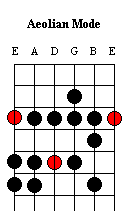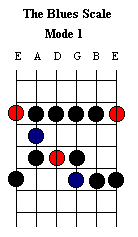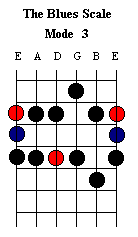

The Blues Scale is made up of 5 notes, these are the Tonic ( 1) a minor 3rd (b3) a perfect 4th , a perfect 5th and a minor 7th (b7). Any scale which only has 5 notes is commonly called a Pentatonic Scale. So why are there 6 notes in the diagrams ?? Often the diminished 5th (b5) is added to give an even Bluesier effect. For easy identification I have made the b5's Blue and the Tonic as usual is in Red.
In the full length version on the left the Tonics are all the same note. So if you were playing the A blues scale all the Red notes would be A's. In the Modal diagrams below, however, the Tonic relates only to that Mode. So the Tonic of the Mode 2 is really the second note of the Blues Scale. eg if Mode 1 starts on A , then Mode 2 would start on C, Mode 3 on D, Mode 4 on E and Mode 5 on G. Just like the Major or Minor scale Modes, they can be used individually for improvising over different chord types depending on the scale formula. (See Table Below)
As far as improvisation goes, just about any note can be used effectively in a Blues Progression. The use of passing notes like the b5 are useful in breaking out of the pentatonic format. Whole Tone, Diminished (1+2) and Chromatic scales can all play a part in providing interesting melodies against the chordal background. It is really a matter of style and taste, as to how you create your improvisation or melody line. Dissonant notes can sound IN depending on what note preceeds it and what note follows.

For a Jazzy Blues feel use the Dorian Scale (Mode 2 of the Major Scale) which adds the 9th and 13th chord tones. For Minor Blues Progressions it is preferable to use the Aeolian Scale (Mode 6 of the Major scale or Mode 1 of the Natural Minor Scale).

 |
 |
As an example of how you can use the Blues Scale Modes individually, lets look at an altered E7 chord. Altered, just means that either the 5th or 9th of the chord have been altered, raised or lowered. eg an E7#9#5 or E7b9b5 or E7#9b5 or E7b9#5 . In an A Blues Progression,for example, this chord is sometimes used to good effect in bar 12 to lead back into the I chord A. As we have been playing the A Blues scale over the progression and have become quite familiar with it, we now come to our altered E7 chord in bar 12.
Usually a scale like the Super Locrian is an appropriate choice for this chord type, however as we may not know that scale we will just play a G Blues scale instead. Just by dropping down a tone (or playing the Blues Scale a minor 3rd above our altered chord) we are in effect playing a Super Locrian scale. The notes we would be playing in the G Blues Scale are : G , Bb, C, D and F. What these notes relate to in our E7 altered chord are: G (#9 of E), Bb (b5 of E), C (#5 of E), D (b7 of our E7 chord) and F (the b9 of E). So, to sum up this idea, you can take a familiar scale or mode and apply it in a variety of different ways. I wish someone had shown me that trick when I was first learning !!
| Mode 1 | 1 | b3 | 4 | 5 | b7 |
| Mode 2 | 1 | 2 | 3 | 5 | 6 |
| Mode 3 | 1 | 2 | 4 | 5 | b7 |
| Mode 4 | 1 | b3 | 4 | #5 | b7 |
| Mode 5 | 1 | 2 | 4 | 5 | 6 |
 |
 |
 |
 |
 |